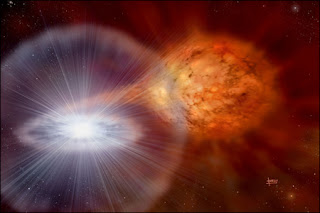Introduction
At the very beginning I must tell you that I am an amateur
astronomer and have no pretensions to know astronomy at any great depth.This
article should have been titled basics of star gazing but I have included a few
useful astronomical informations (for a layman)and hence the title.
Almost everyone of us at some point of time looked at the sky
and watched the stars,the sun and the moon and wondered what they are in
actuality.
That wonderment in my case has lead to many questions and
view the sky more closely.It started accidentaly one night when I could watch
the sky with a telescope and found the
sky an amazing place of infinite beauty and mysteries.
It is not a very easy job to watch sky with a telescope
(unless you use very modern computerised go to telescopes) and find objects of
interest.The biggest objects in the sky,the sun and the moon has an angular
diameter of almost half a degree which is very small when you consider the sky
you see has an angular diameter of 180 degree at any point of time (half of the
sky is below horizon, otherwise it would have been 360 degrees.) However to
catch the moon and sun is realtively easy in telescopes.The catch comes when you
want to see the other dim objects which are the things for which you are using
the telescope in the first place.
To begin with you must be familiar with the sky.The best
thing is just go to your terrace and lie down and look upwards. If you do this
for a few days slowly the patterns of sky will be familiar to you. You need a
basic skymap to guide you.I found a little book in Bengali written by Biman
Bose named Nakshatra Porichoy which hepled me a great deal.You can buy or
download some small star map for your help and gradually develop on that.As a
beginner you can use Star Maps for beginners by I.M.Levitt and Roy K Marshall.Later
on Wil Tirion’s Sky Atlas 2000 may be used for medium and advanced level. In a
computer you can use the free software Stellarium for easy guidance.
If you look at the sky now ( it is October and place is
India,Kolkata) you will find three bright stars almost at the middle of the
sky.These are Vega, Deneb and Altair.The indian names of Vega nd Altair are
Abhijit and Shravana respectively.These three stars are popularly called summer
triangle. (For your information Vega will be our pole star at around AD 13,727). Vega is in the constellation
Lyra,Deneb in Cygnus and Altair is in Aquila.For your information
constellations are nothing but groups of stars which form a pattern in sky and named for easy reference
and recognition.These stars may be close together or far from each other and
only their position in the sky which makes them to be in the same
constellation.As you go on familiarizing your self with the sky you will be
able to recognise stars and constellations immediately.
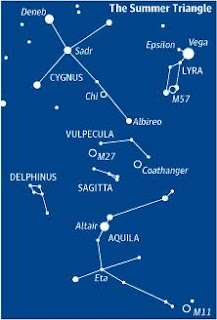 |
| Summer Triangle |
Type of Telescopes
Once you know the
bright stars quite easily you can begin to navigate in sky the with your
telescope.There are generally three kinds of telescopes which are available for
visual observation.
1)
Refractors
2) Reflectors or Newtonians
3) Catadioptric (Schmidt or Maksutov - Cassegrain.)
Refractors use
combination of lenses to form a image of an object which is viewed by an eye
piece.These are the oldest kind of telescopes and was used by Galileo
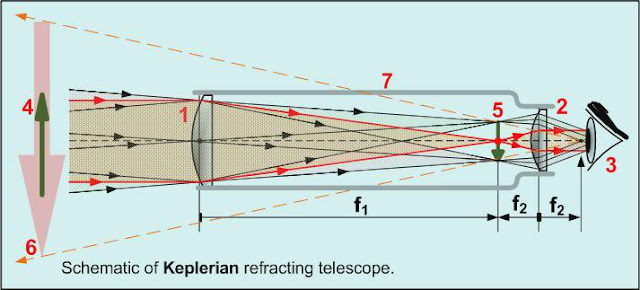 |
Schematic Diagram of A refractor
|
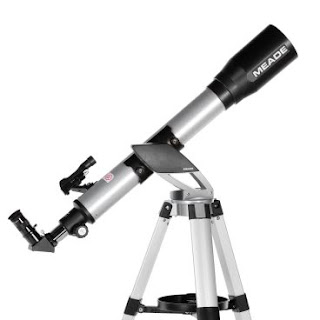 |
| A refractor telescope |
Relectors use parabolic mirrors to form an image of the
object and is viewed by the eye piece lense.This was inroduced by Newton and
hence it is also called Newtonians.These are by far most popular and cheap and
used by most amateurs.These can be built at home with a little patience and
hard work.
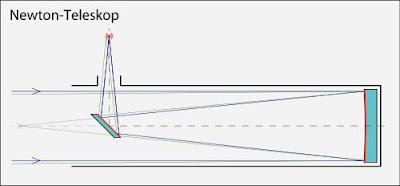 |
| Schematic Diagram of a Netonian Telescope |
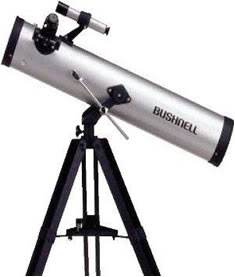 |
| A Reflector (Newtonian) |
Catadioptrics are
more complicated modern version telescopes which uses both concepts and the
light is reflected several times in telescope tube which makes them very
handy,easy to use and very good resolution capabilities.Modern computerised go
to telescopes are mostly of these types. But they are costly.
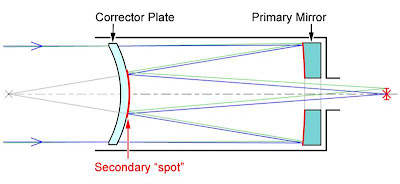 |
| Schematic Diagram of a Maksutov Cassegrain Telescope |
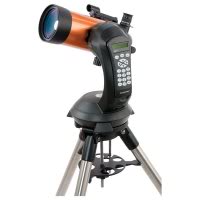 |
Maksutov-cassegrain computerised telescope
|
For sky watching you need at least a 3 inch (75 mm)
refractor or a 4 inch Reflector or cassegrain telescope.
Type of Mounts
Supposing that you have acquired a telescope you have to
choose the mount of the telescope.There are two types of mounts
- Altitude-azimuth
- Equatorial
In alt-azimuth mounts telescope can be rotated in horizontal
and vertical axis .This is useless for sky watching unless you have
computerised telescope like celestron nexstar.
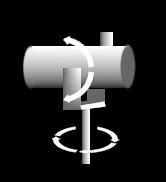 |
Alt-azimuth mount
|
In Equatorial mount one of the axis of the telescope is
parallel with the axis of the rotation
of earth (polar axis). As you know as the earth moves from west to east at a
fixed rate.The celestial objects moves in the sky in the opposite direction
(i.e east to west) at the same rate.Once one of the axis is aligned with axis
of earth’s rotation you can track a celestial object in the sky continuously once
you find it just by rotating your telescope in polar axis.Unless you do that
the object will move away continuously out of field of your telescope.
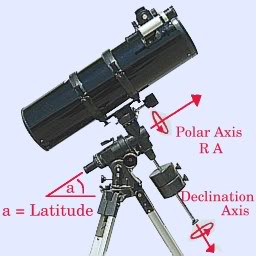 |
Equatorial mount.
|
Right Ascension and
Declination
You can imagine the sky as big opaque vault on which
celestial bodies are embedded.As the sky moves from east to west the bodies are
also moving from east to west and their positions are fixed on the
sky.According to its position each body has a celestial coordinate just like
each place on earth has a latitude and longitude.In astronomical jargon they
are called Right Ascension and Declination. Right Ascension or R.A is like latitude
an is measured from an imaginary point of sky known as FIRST POINT OF
ARIES.Declination or DEC is like longitude and is measured 0-90 degrees from
celestial equator( celestial equator is parallel to earth’s equator in
sky).Every celestial body has a fixed R.A and DEC except sun,moon and planets
whose movements are more complicated.
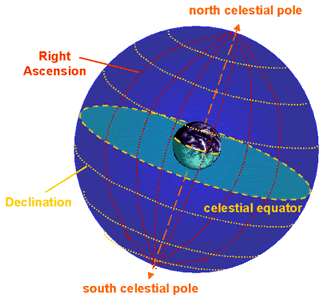 |
| Right Ascension and Declination |
Polar Alignment
The next thing to do is to polar align your telescope.If you
are in northern hemisphere it is easy.First you have to identify the pole star
or Polaris.Then make the adjustments so that the RA axis of your mount is so
that your guider scope points at Polaris.Then make further adjustments with
your main eye piece lense so that it is in the centre of eye piece.Actually the
north celestial pole is less than ½ degree away in RA and and less than a degree in DEC and it
is helpful for ordinary viewing.For astrophotography you need much more
rigorous and accurate polar alignment.
Before I return to star gazing I want to give you an
important information.The bigger the aperture of your telescope objective lense
or mirror the more light gathering power it has and you can see objects dimmer
and farther away in space.
Star Hopping
Now that you have a
telescope and mounted in polar axis you can start finding a celestial object of
your choice. Finding a celestial object in sky is not easy as I told you
earlier because they are very very small.Most celestial objects does not have
an angular diameter more than a few arc second or minute. It is like finding a
pin in a big warehouse.
The trick is to find it by its neighbourhood.Just like you
go to some unknown place by knowing a landmark near it.Suppose you know a star
and you know a dim object (a nebula or
galaxy) is nearby.You go to the next closest star using your star chart until
you finally arrive to your desired object.
But to do this you have to know the magnification and true field of view .
Magnification = Focal length of telescope (in mm) ÷ Focal
length of eye piece. (in mm)
My telescope has a focal length of 1300 mm.If I use a 25 mm
eye piece the magnification will be 1300 ÷25 = 52 that is objects are magnified
52 times.
Now the True field = Apparent Field of eye piece ÷
magnification
Apparent field of eye piece is supplied by the
manufacturer.The 25 mm eye piece has an apparent field of 52 degree. Therefore
the true field = 52÷ 52= 1˚.
(The following portion of Star Hopping is adapted fom an
article from NIGHT SKY INFO)
If you don't know
the apparent field of the eyepiece the matter becomes a little more
complicated... In order to find out the visual field of the eyepiece in this particular
case, you should direct the instrument to a star as close as possible to the
celestial equator, set the star at the edge of the visual field and measure the
time it takes for the star to cross the eyepiece, without moving the
instrument. Knowing that a star near the celestial equator will move one degree
every four minutes, you can calculate the visual field of the eyepiece.
Now
that you know the visual field and the scale of the atlas you can make either
wire or plastic rings that will represent the field. If the eyepiece has a
visual field of two degrees and the scale of the atlas measures 8-mm per
degree, the ring should have a diameter of 16-mm. The ring is extremely useful
when the object to be localized is found in an area of the sky with very few
stars, normally it is not used too often.
In
order to find a celestial object with the star hopping method, the visual field
of your eyepiece should be as large as possible, so don't use great
magnification. This way you will be able to see several stars in the field, and
will have reference points. Only when you have found the desired object should
you use eyepieces with great magnifying power.
The finder-scope
The
finder attached to the main instrument is also very important. It would be
great to have a finder with an aperture as large as possible (50-mm would do
best). With a six to seven degree visual field, such a finder will point far
more stars than visible with the naked eye, thus being very easy to identify
the area where the target is. You can determine the visual field of the finder
with the help of methods described so far.
Coping with mirror or inverted images
According
to the type of instrument you are using, the images will be either inverted or
reversed (mirror image). Newtonian telescopes give an inverted image (north
becomes south), while instruments with a diagonal (a small mirror) will give
reversed images.
The
solution every time you use a Newtonian telescope is simple: turn the maps
upside down. The problem occurs with instruments using a diagonal. A solution
is to flip over your sky chart and shine a light behind it to view a mirror
image of the printing through the paper.
A little theory...
In
order to start a star hopp the first step would be to identify on the atlas the
area where your aimed object is. After this find a star, or a group of brighter
stars visible with the naked eye and situated as close as possible to the
target.
Without
looking through the finder or telescope, with both eyes opened, look along the
instrument and point it to the area of interest. The point is to center in the
finder, after having consulted the atlas, a group of stars that stand out among
the rest. It is extremely important that this point of reference should fit
into the visual field of the finder so that it may be recognized even if it is
not centered perfectly.
The
more difficult part is to memorize the shape of the pattern formed by the group
of stars, in some cases you may need to return to the group after having passed
by it. Confusions may occur in case you mistake a group for another, only to
finally find yourself a few degrees away from the targeted object. The solution
is to associate a familiar shape to a group of stars (line, triangle, circle or
square), thus you will succeed in memorizing them more easily.
And the real thing. Star hopping exercise
M92
is a beautiful globular cluster in Hercules, about 26,000 light years distant
from Earth. It is an easy target even for small telescopes, and on clear nights
it can be spotted with binoculars, if you observe on a dark sky far from city
lights.
For
this star hopping example let's say that your finder-scope's field is five
degrees
and the eyepiece field is one
degree. The large circle represents the field of the finder-scope and the small
circle is the field of the eyepiece.
To get to M92 first locate the
bright star Pi Herculis, shining at 3rd magnitude. Center it in the field of
your finder-scope and sweep one more field, following the line drawn from Pi to
Iota Herculis. At the edge of the field look for four stars arranged in a line,
and center them in your eyepice. Move one degree in the direction of Iota
Herculis and M92 will be right in the center of your eyepiece.
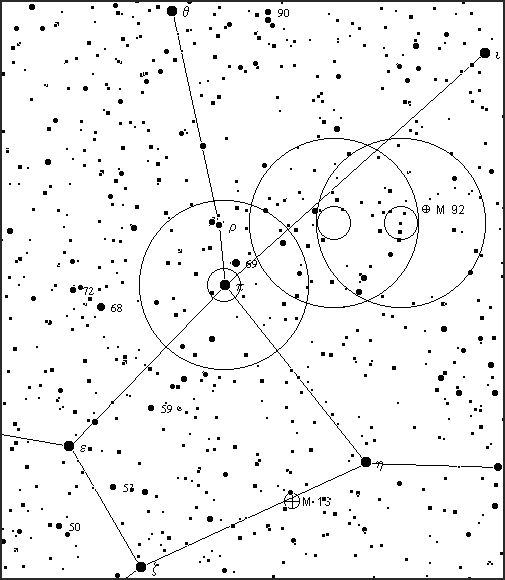 |
Spotting M92
|
Modern GO TO Telescopes :
Modern
computerised telecopes has almost made old star hopping techniques as a thing
of past But they are costly and I would suggest that beginners should use old inexpensive
telscopes to begin with.Knowing the sky and discovering objects are half the
fun of stargazing.
GO TO telescopes
computerised software to locate a celestial object.What you have to do is just
have your telescope looking at the sky,align it with some bright stars (unknown
or known to you) and press the button to move the telescope to find your
desired object.This has made astronomy easy and almost child’s play.Some
amateurs are now finding supernovas very soon without much struggle.These
telescopes even do not require them to be on an equatorial mount. They are
mounted on alt-azimuth mounts and once it latches on an object it goes on correcting the alt-azimuth
according to the RA and DEC of the body with time so that it is always in the
field of telescope.Some telescopes include global postioning systems so it gets
its own information about where you are.However for astrophotography accurate
and rigorous polar alignment is needed even with these.But the most modern ones
have all star polar alignment systems which makes it also much easier.However
these are quite costly at present and it is a matter of subjective opinion
whether you should buy it as your first scope.
Apparent magnitude of a celestial body:
The apparent magnitude of a celestial body is a measure of its brightness
as seen by an observer on earth, normalized to the value it would have in the
absence of the atmosphere. The brighter the object appears, the lower the value
of its magnitude. Celestial objects with apparent magnitude upto 6 is said to
be visible to a naked human eye in a dark ,clear night although genrally we can
see upto 3 rd magnitude stars. The sun has a apparent magnitude of -26.74, full
moon -12.92, Sirius the brightest star -1.47,Vega 0.03, .Polaris 1.97and
Andromeda galaxy 3.44.
Useful formulas :
116
Resolution = ——
seconds
D
D = Diameter of
telescope in mm.
Example: A 10" (254 mm) telescope
116
Resolution = —— = 0.5 seconds
254
The size of an image depends on the focal length of your
telescope. For example, the longer the focal length, the larger the object:
fθπ
w =
————
180
w = width of
image
f = focal
length
θ= apparent diameter ( i.e Moon = 0.5˚ )
How faint an object a telescope can see
m = 2.7 + 5 log D
D = Objective lense diameter
Where m is the limiting magnitude. Example, our 10"
telescope:
m=2.7+5 log254
= 14.7
The faintest object a 10" telescope can see is with a
visual magnitude of 14.7 (Pluto has a magnitude of around 13.8).
f/number = Objective Focal Length / Objective
Diameter. Example: A 2000 mm focal length telescope that has 200 mm (8
inch) diameter yields a value of f/10.
Exit pupil = Objective Diameter / Magnification = Eyepiece
Focal Length / Objective f/number
Some data about celestial objects:
Moon: This is the
closest of all celestial bodies fom earth and a natural satellite of
earth.Although man has already landed on moon it is the first object a beginner
would like to view from his telescope.Great details of moon are visible even
from a small telescope and it is the easiest object to align.However moon’s
movements are a bit complicated as it goes eastwards almost 12 degrees every 24
hours.Moon filters can be used to increase contrast and bring out details of
moon surface.
 |
Moon’s surface.
|
Planets:As we all know our solar system has 9 planets
namely Mercury,Venus, Earth,Mars,Jupiter,Saturn, Uranus Neptune and Pluto.From
a small telescope Venus,Mars, Jupiter and Saturn are quite a view and lots of
time should be spent on that.Viewing mercury is difficult because it is very
small and close to sun but is possible.Uranus and Neptune are small bodies like
stars from small telecopes and it takes a big telescope to get Pluto in the
view.
Venus: Venus is popularly known in Bengal
as Suktara or Sandhyatara according to the time it rises in east and west
respectively.In addition to the movements like star the planets slowly move
from one zodiacal constellation to other because of their motion around the
sun. These sometimes causes viewer to see retrograde motion of planets ( they
seem to move on back gear) .Zodiacal constellations are those which lie within
almost 10 degree north and south of the ecliptic,i.e, the yearly motion of sun.
 |
| Venus |
Sun:It is the closest star from earth and even a
small telescope shows sunspots on it.Remember to take special precaution while
watching sun through telescope..use a filter from a reputed company like
celestron to completely cover the objective (the main lense or mirror) of your
telescope (do not use filters which covers the eye piece lense which can be
easily destroyed from the heat gathered by sun’s ray). Do not look at the sun
directly even with the guider scope .Without these precaution you can be
blinded for life time in a fraction of a second.
• The best time to observe the Sun is in the early morning
or late afternoon when the air is cooler.
• To center the Sun without looking into the eyepiece, watch
the shadow of the telescope tube until it forms a circular shadow.
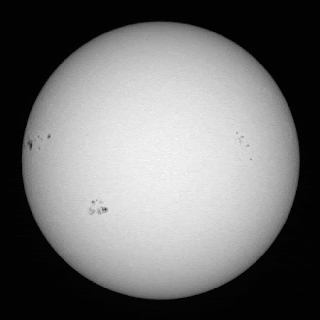 |
Sun spots
|
Double stars: a double star is a pair of stars that appear close to each other in
the sky as seen from Earth when viewed through an optical telescope. This can
happen either because the pair forms a binary star, i.e. a binary system of
stars in mutual orbit, gravitationally bound to each other, or because it is an
optical double, a chance alignment of two stars in the sky that lie at
different distances.Albireo, which is close to Deneb in Cygnus is a bright
double star,actually a binary.There are also multiple star systems where more
than two stars are gravitationally bound to each other.
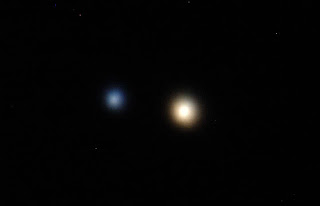 |
Albireo
|
Nebula: A nebula is an interstellar cloud of dust, hydrogen ,
helium and other ionized gases. These
are within our own Galaxy,i.e,Milkyway.Sometimes new stars form in nebulae like
Orion nebula which is visible in the south of orion’s belt.
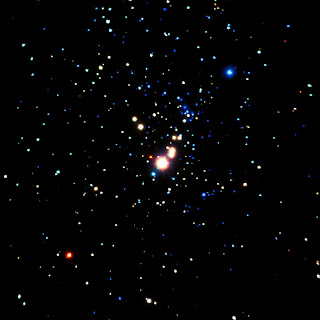 |
Orion nebula
|
Galaxy: A galaxy
is a massive, gravitationally bound system that consists of stars and stellar
remnants, an interstellar medium of gas and dust, and an important but poorly
understood component tentatively dubbed dark matter.Our solar system is part of
our own galaxy Milkyway.It is spiral galaxy with diameter about 100,000 light
years and containing 200-400 billion stars.There are billions of galaxies.The
closest spiral galaxy is Andromeda almost 2.5 million light years away and a
naked eye object in a dark clear night and visible with a small telescope.
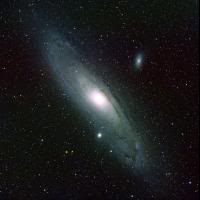 |
Andromeda Galaxy
|
Open clusters : An open cluster is a group of up to a few thousand stars that were
formed from the same giant molecular cloud and have roughly the same age. They
are loosely bound to each other by mutual gravitational attraction. Most
notable open clusters are Pleiades (indian name Krittika) and Hyades and are
visible with naked eye and are beautiful viewing objects with a telescope.
 |
Pleiades.
|
Globular clusters: A globular cluster is a spherical collection of stars that orbits a
galactic core as a satellite. Globular clusters are very tightly bound by
gravity, which gives them their spherical shapes and relatively high stellar
densities toward their centers. Globular clusters, which are found in the halo
of a galaxy, contain considerably more stars and are much older than the less
dense galactic, or open clusters.
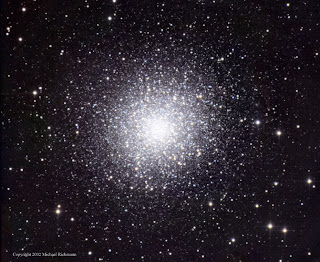 |
Globular Cluster.
|
A few words about
astrophotography:
For astrophotography you need to have very accurate Polar
alignment of your telescope.It is done with the help of setting circles (in
modern GO TO telescopes setting circles need not be there) and using the drift
of stars.Photography can be done by DSLR cameras either mounted piggy back on a
telescope or at the back of it using a T-ring and T-adapter to latch your
camera with the telescope. In the latter case telescope itself becomes a big
telephoto lense.To take photographs of very dim objects you need to take long
exposure photographs.
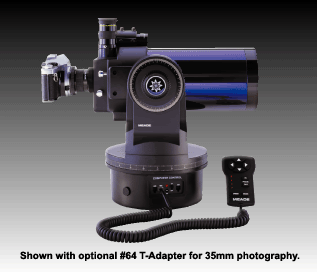 |
Camera at the back of telescope
|
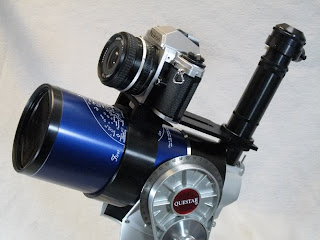 |
Astrophography with camera mounted piggy back on telescope.
|
That’s all folks.















